
|   |

|   |
Prayag - Padma Jayaraj e-mail: padmajayaraj@gmail.com December 10, 2013 Prayag is a Sanskrit word for the confluence of rivers. To a Hindu mind, it connotes the sacred coming together of two rivers in the Himalayas forming the Ganga. Life-giving waters have flowed since aeons from it creating and sustaining life and culture in the plains below. The artist couple, Prayag Jha and her husband Jai Karan Chillar have created a wonderful artscape ever since their confluence half a century back. Their exhibition at Jahangir Art Gallery (26th November to 2nd December 2013) celebrating fifty years of life together as artists, is a testimony to a sacred confluence that creates art and culture. The display in the hall epitomizes years of artistic creativity that complements and supplements each other’s talent in the intimacy of five decades of togetherness. 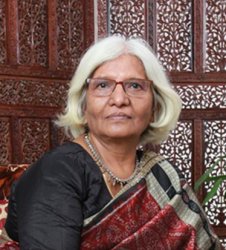 Prayag Jha 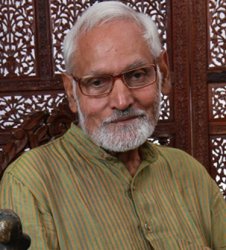 J K Chillar On the walls, her paintings of windswept landscapes in myriad hues where shrubs in flowers dominate, mark the bounds of the happy terrain of their intimate life. The celebration of joy that the beauty of nature stirs up is the sum and substance of her paintings. Expressed in permutations and combinations of various shades and shapes, her paintings are inviting. As you move from one to the other they lead you from joy to exhilaration, changing your mood. A prayag of blossoms flourish and flow chastening and enriching your inner self. Here is an artist for whom nature is sacred. Yet, she lapses into godliness with pictures of Krishna, Siva and Kali. But these cult figures have human contours and are projected as part of the land, its background. Krishna is a tribal shepherd with his cowherd and Siva the nucleus of an austere terrain, while Kali is a bold girl. The few human figures that make their presence, also feel the force of the wind as the plants in flowers do. Oil or acrylic on canvas, some of them are orchestration of monochromes. Etching with different themes is another field of her artistic expression. She has done a visual rendering of Kalidasa’s Meghadooth, the epic creation of an ode to love. Etching is a unique art that demands patience and perseverance. Drawing with a sharp needle-pen on a zinc plate is the first step. After treating the carving with acid, a roller printer is used to transfer it on to paper. Trained in graphics, etching comes naturally to her. In fact, Prayag is the most accomplished artist honoured in India in the field of etchings. Meghadooth is the product of a Fellowship which she intends to publish soon. 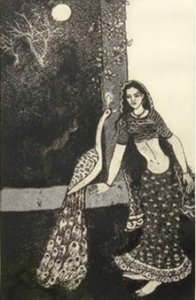  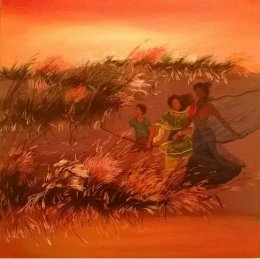 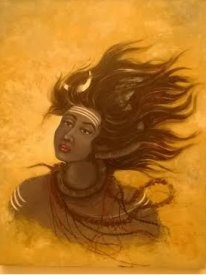 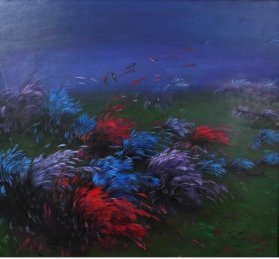 Paintings by Prayag Jha Encapsulated within these limits of love and divinity is another world, humane. Her husband’s artistic creations populate the terrain. Its deeper layers unravel happiness, success, faith, and the values that give meaning to human existence. J. K. Chillar’s work is curated as if the artist is casting a long lingering look back into his past. His sculptures, both abstract and figurative, cast in marble and bronze reveal his stature as a national artist. A post graduate in stone carving from MS University in Baroda, he has retained the passion for sculpture all along. His drawings on the wall, preludes to his carvings, surprise you with their flowing lines. The rhythm that shapes his sculptures has flown from these dancing lines. And there is an unusual softness that is strange in stone work. The abstract form of Ganesh, in marble, looks like a lump of butter. “He has given me everything...,” says the artist with a soft look on his face. “Many a time when there was nothing at home, I began carving Ganesh. Someone materialised giving an advance booking for the finished product.” “The marriage was our choice and we had to start from scratch,” his wife confided. 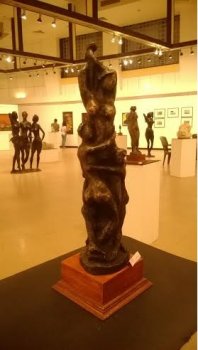 Bronze sculpture by JK Chillar 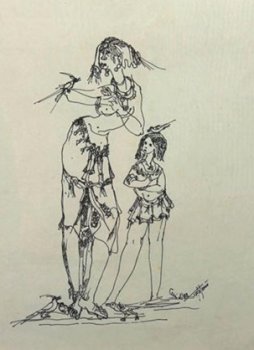 Line drawing by JK Chillar “Ganesh has given me everything I have.” You sense the ineffable love, not just devotion that has created the piece. Whenever he starts a project he begins with carving a small Ganesh. Looking back, after fifty years the struggle was worth it. Based in Bombay, they established themselves. He has remained a creative artist despite a few teaching assignments. And together they brought up a family. The statues of families that stand for happiness, success, unity etc., are organic pieces of men and women entangled by children. The Indian family tradition is the heart of the piece that invests it with emotion. But for a few human figures poised to look at life, we find groups of figurines. Women fill up his world as if he is aware of the golden ratio of human race. “My mother used to say that the woman is the most beautiful being, depending on how you look at her.” Bonding is the predominant thesis of these figurines, which is natural to women. It is a nobler feeling far removed from possessive love. Pointing to a life size group of young women cast in bronze, he recalled how he watched foreign maidens in a sportive mood, bathing in the sun on the shores of Goa. Apparently a human head, dispassionate and serene, looks like that of Shirdi Sai Baba from an angle, human and divine, one containing the other. While the drawings on the wall showcase bulls ready to fight, the statues of bulls that dot his locale are reminiscent of Nandi, the bull at rest. Rural rhythms resonate in his pastoral setting. They are memories of his boyhood home in Haryana, where he had tended land and looked after cows and bulls, whence he had known their affection and loved them in turn. Here, you sense the connect that binds the two artists, in this pastoral land, where every wind that blows, every shower that wets make meadows full of shrubs that burst into blossoms - prayag, the confluence of two streams that creates a sacred river. 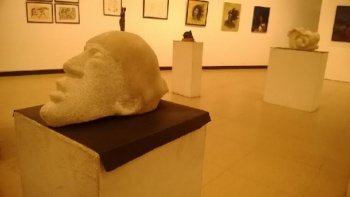
Sculpture by JK Chillar
Call it the irony of life or changing times. The astral blossoms born of this confluence do not partake of its rainbow colours. Their eldest son chose medicine; the second is an adept in the field of engineering while their only daughter belongs to the corporate world. Strange are the ways of genes! Devaprayag in the Himalayas is a town today, far removed from our concept of sacred confluence. Like the family tree that J.K. Chillar has sculpted, the Chillars present an organic whole knit of divergent strands. Padma Jayaraj is a freelance writer on the Arts and travel and is a regular contributor to narthaki.com |